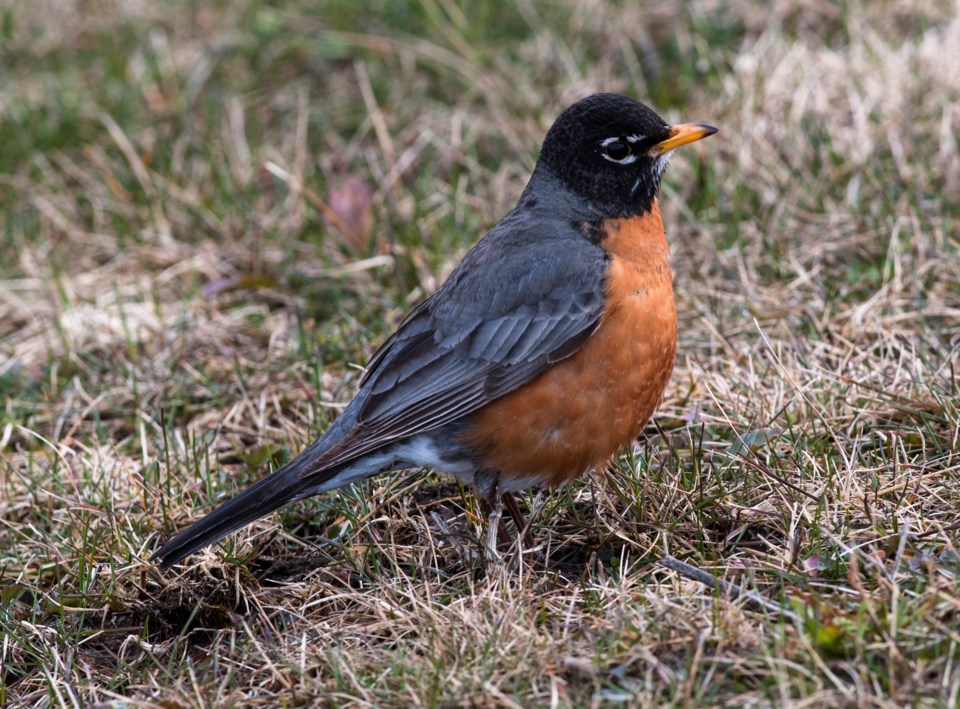If that’s a red-red-robin bob-bob-bobbing across my lawn, I guess it’s a bona fide sign of spring!
Individuals of this species have been trickling back into the neighbourhood since mid-March but now there is a flock here and a flock there.
The emotional response to seeing that first robin in the springtime has been well captured in Harry Wood’s 1924 song, and by several famous vocalists including Lillian Roth, Al Jolson and Doris Day, who have kept the uplifting lyrics bobbing along for decades.
A look at the Ontario Breeding Bird Atlas shows that the American Robin has been observed in every square kilometre of southern Ontario, with a drop in abundance once the heavily treed Canadian Shield zone is reached. If you have a grassy lawn, you probably also have robins in the immediate area.
Note that the ‘American’ in its common name refers to North America, also referred to as the New World by ancient naturalists. Sharing this prefix are also the American goldfinch, American woodcock, American bittern, American kestrel and several others. These are native species of North America that European explorers ‘discovered’ and named.
To appreciate the name ‘Robin’ one must go back to the 14th century and look at the Old French language, where the name began. A friendly buddy was referred to as “Robert” or “Robby”… and the European robin (no relation to the North American bird) was a common companion while working the gardens.
Around the 1500s the name was picked up in England and the small, perky, red-breasted bird was officially bestowed the name “Robby.” But the name became a catch-all for any small songbird, with sparrows, swallows, wrens and others all being referred to as robins (or friendly buddies).
When European-based explorers, traders and colonists arrived in North America, the sightings of these rusty-breasted birds garnered their new name of American Robin.
In the 1600s, 1700s and early 1800s the robin was a woodland nesting bird, which hunted grassy clearings for beetle larva and other grubs and bugs. As settlements cleared the woods and created first the fields and later high-class lawns, the robins took kindly to this gesture of expanding habitat.
These birds altered their nature of having well concealed nests constructed high up in old oak and elm trees, to being quite happy building atop lantern hangers and later porch light fixtures.
Known for their pre-dawn singing, the male robins establish a territory within which the female will build the nest and incubate the eggs. The males vigorously defend their boundaries but overlap is common in high density populations.
While the females are sitting on the eggs and when the nestlings first hatch out, the male will dutifully bring food to the sitting partner and later the clamouring youngsters. Once the little ones flutter away from the nest, he will be their guardian whilst Mom rebuilds the nest for the next brood.
Back in the 1950s and 60s, robins inadvertently warned us of the misuse of chemicals such as DDT. Large die-offs raised the question “what’s that all about?” and the cause was quickly determined to be the heavy application of pesticides to stop the insects that were carrying the fungus that killed elm trees. Thus began a much more rigorous program of labelling and researching of these chemicals.
But even today the robins are being affected by urbanization, as the males are singing earlier in the morning due to street lights being on, and singing louder to be heard over urban traffic.
And about that worm these early birds vie for ... there are no native earthworms around here; any such species were wiped out by the Wisconsin glacier as it slid over this region about 60,000 years ago. The earthworms that robins so skillfully pull from our lawns are imports, non-native worms that came in with soil or ship ballast from Europe.
So Mr. Wood’s 100-year old song needs a refresh: “When the native but foreign named bird goes bob-bob-bobbing along the artificial lawn habitat created by Colonists, and pulls up an introduced species of worm which has maybe (or not) escaped sod-soaked chemicals… it’s spring!” Hmm, needs work.
